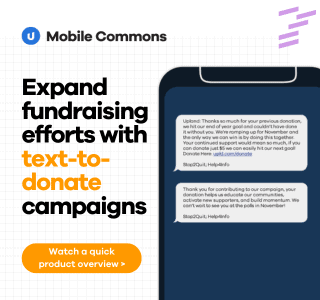
Visit any college campus and one of the most common scenes you’ll notice will be students with their heads down.
No, it’s not because they’re miserable and wishing they didn’t choose an Engineering degree, but rather because they’re in a serious relationship – with their phones.
According to research, text messaging (SMS) is the most popular communication method for college students ages 18-29. While primary, texting with friends and family members is not the only audience that college students text. Colleges and other higher education institutions capitalize on text message’s ubiquity by sending operational messages to students. When it comes to engagement, often times nothing speaks louder or clearer than a simple text message. You can bet wherever there is a college student, their phone is not too far away.
Let’s take a look at why using SMS in higher education makes sense.
The Numbers – SMS Data
By now, you have probably read that open rate for SMS is nearly perfect (98%). As soon as your phone chirps or vibrates or blinks or whatever it is that yours does, you can’t help but look. Even if you miss the notification, you will eventually look at your phone, open, and read that message.
The capabilities and reach of SMS are very different from email. Because email is overused and abused, emails are often glanced over, deleted, or not delivered in the first place. SMS, on the other hand, remains an uncluttered, unabused communication channel. Further, 83% of messages are read within 3 minutes and 113% of 18-24-year-olds find text messages for promotions very useful. It’s fairly easy for a college student to overlook an email from their University, but a text message? Near impossible.
Using SMS in Higher Education
When we think of SMS marketing, we typically think of brands or companies that send mobile coupons or something promotional. While this use is common, there are many other uses of SMS, especially as it relates to higher education. Below are a few specialized uses:
- Safety notifications: Send text messages to students regarding imminent danger or inclement weather.
- Urgent messages: Make students aware of building issues, street closures, class cancelations, etc.
- Simple reminders: Are there important dates coming up? Help students remember by sending simple reminders.
- Class registration: Use text messages to confirm which classes students have signed up for and which classes they have not yet enrolled in.
- Surveys: Get feedback and improve campus events and policies by sending quick surveys / polls to students.
- Creative ways to learn: Send students personalized lessons based on how they learn the best.
The effects of SMS on higher education are so prominent that Ben Castleman, a professor at the University of Virginia, and his colleague, Lindsay Page, authored a study that discovered text messaging in a university setting boosted college enrollment by 3.1% and 8.6% among low-income students.
Ben explains, “I think what really differentiates text messaging is that at least for a moment in time … our phone will chirp, it will vibrate, we’ll look at it and for that moment, the text stands out on its own. That’s also unlike an email inbox or a Facebook newsfeed where there’s a lot of content,” said Castleman, who has also written a book on how texting can improve education.
We couldn’t agree more. When used effectively, SMS can do wonders, especially in the higher education arena. Here are a few best practices:
SMS Best Practices
Opt-In
In order to text your students, they must consent to receive messages by simply opting into your program. Mass messaging your students simply because you have their phone numbers is a big no-no and, quite frankly, illegal. It’s easy to set up an opt-in program once you have a compelling CTA and promote that call-to-action in emails, on your homepage, on billboards, and at new student registration. To take it one step further, incentivize students to opt into your program with customer-centric contests and other prizes.
Less is More
You can’t have a successful program without a meaningful message. Take a cue from the U.S. Navy (who popularized the phrase KISS) and Keep It Simple, Sweetie. Unless you’re sending an MMS message (video, picture, or longer than 160 characters of text), you must keep your characters below 160. Aside from message sending requirements, this character limitation will prevent you from writing unnecessarily long messages. Use SMS to send time-sensitive information, quick reminders, or interactive messages. And remember, at the beginning of your message, identify yourself. Place your institution’s name at the beginning of the message to let your students know who’s texting them.
Messaging Frequency
The immediacy and intimacy of SMS wields marketers immense power – the direct access to a recipient’s attention span at all hours of the day. Abuse this power and you will find your program in the dog house and most likely unsubscribed from. In order to remain effective and unintrusive, companies must be cognizant of their frequency and time of day for messaging.
Analyzing data from our ten years of messaging, we found that an optimal messaging frequency was 10-12 messages / month. Any more and you may violate the personal space of your subscribers, any less and your subscribers may actually forget about you. For any new SMS program, experiment to find your sweet spot. Start by sending 4-5 messages per month and track performance. Slowly increase messaging to approximately 10 per month to increase customer lifetime value. Remember, every program is different – what works perfectly for one company might not work at all for another. The key is experimenting and analyzing results.
Think Cross-Channel
Optimize your marketing across multiple channels by using SMS efficiently. Send students a link to a specific page on your website such as registering for an event or purchasing tickets. Promote your social campaigns by sending links to your social media pages and easily prompt students to visit those pages. Use your email marketing to promote your SMS campaign by including a call to action for recipients to sign up. All of these cross-channel methods help to engage students and get your message heard across multiple touchpoints.
SMS and higher education are an excellent, grade A match. With these best practices and a savvy mobile marketing provider, you should be well on your way to creating unique and helpful experiences. To learn more about setting up an SMS campaign, check out a demo.


